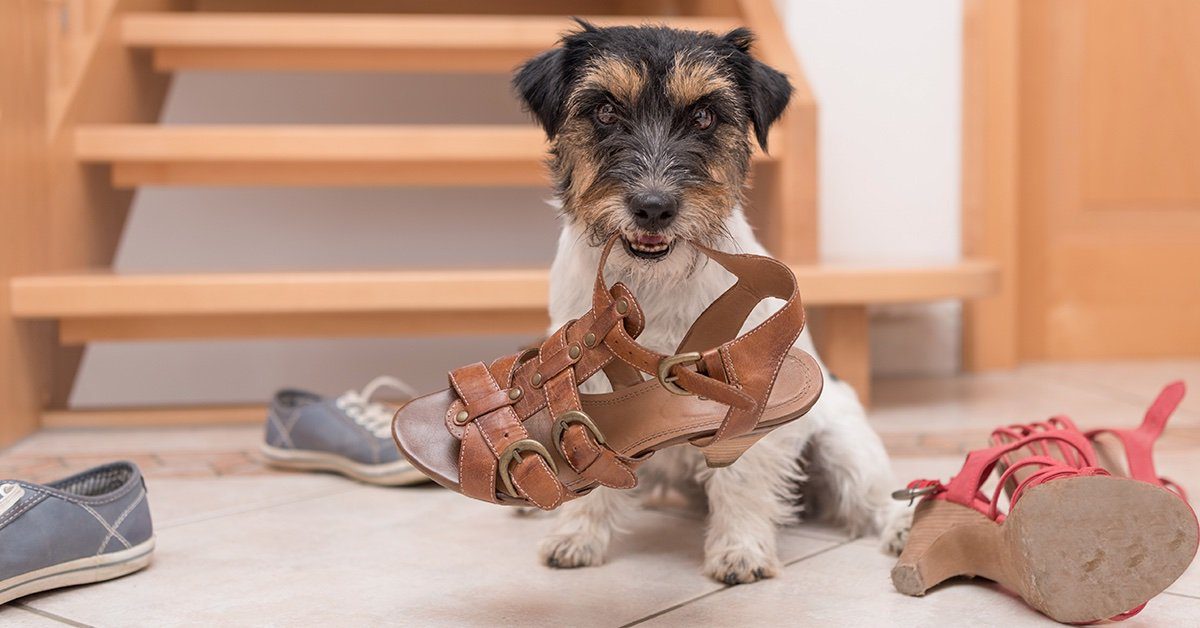You’re so excited to bring home your new puppy! And there’s no doubt you’ve started crossing items off your new puppy checklist – you’ve researched food options, started stocking up on puppy supplies, and read up on some standard puppy tips. Now, you’re ready to prepare your home for the arrival of your new companion.
Puppy proofing your home is all about making sure that your environment is dog-friendly to keep your new pup safe. After all, puppies will go through a teething phase and tend to explore things with their mouths, so anything you don’t want to be chewed or nibbled on should be out of reach.
Not sure how to get your home ready for your newest family member? Our puppy-proofing guide is here to help. Let’s get started.
How to Puppy Proof Your Home in 4 Steps
Whether you’re an experienced dog owner or you’re getting a puppy for the first time, puppy-proofing is an essential step to take before that first night with your new puppy.
Follow these four simple steps to learn how to puppy-proof your house.
1. Decide which spaces your new puppy will and won’t be allowed to access
Before you even start the actual puppy proofing process, take a look around your house and decide which areas your new dog will be allowed to access. Make sure that you have this discussion with all of your housemates/family members so that everyone is on the same page.
If your new puppy isn’t going to be allowed in the basement, for example, you might worry less about puppy proofing that space – and instead, ensure that your puppy cannot get into that area at all, either by putting up a baby gate, keeping the door shut, or even locking the door.
By making these decisions ahead of time, you and your family can streamline your puppy proofing process, and make sure that you’re focusing on the areas that your new dog will actually be exposed to.
2. Designate a safe space for your puppy
Next, you’ll want to designate and create a safe space for your new pup. If you plan on crate training your puppy, this location should include their crate – and might also include their dog bed, blankets, chew toys, and other items to make your dog feel at home.
Depending on the size and layout of your space, you might use a baby gate or playpen to section off part of your home or part of a room where your puppy will be spending time during the day, allowing you to create that safe place for your pup.
Generally, you want to designate a space where your puppy can play but also rest quietly. A specific part of your living or family room can be a good location, especially if you’re putting your puppy’s crate in that area. Just make sure your puppy isn’t too isolated – you’ll want to keep an eye on them, and your nearby presence will give them comfort!
3. Puppy-proof your space indoors.
Once you’ve identified the locations where your puppy will be allowed and you’ve created a dedicated safe place for your new family member, you’re ready to begin the actual puppy proofing process.
Here’s a puppy-proofing checklist you can follow to make your indoor space as safe as possible for your pup:
- Secure trash cans. Your puppy may be attracted to the smell of discarded food or other items coming from the trash, so you want to make sure that your trash cans have lids that close tightly and that bins can’t be knocked over. You might also consider keeping trash cans away and out of your new pup’s reach.
- Be careful with human food. Although some human foods are safe to feed to dogs, there are a variety of foods that are unsafe and can make your pup sick. Toxic foods include avocado, onions, grapes, chocolate, and xylitol (an artificial sweetener found in gum, candies, and other snacks).
- Move or unplug electrical cords, chargers, and other wires/cords. These types of wires can be tempting for curious puppies that like to chew. If you can’t move or unplug certain wires, you can secure them out of reach or string them in cord concealers to avoid any electrocution or strangulation risk.
- Keep house plants out of reach. If you have house plants, you should store them on a high shelf or another place that your dog cannot reach, so they are not able to chew the plant or knock it over. Alternatively, you might decide to avoid house plants altogether, as many popular plants – ivy, lilies, aloe vera – are poisonous to dogs (and cats).
- Lock away cleaning products and household chemicals. Make sure to lock away cleaning supplies, such as bleach, ammonia, air fresheners, disinfectants, detergents, soap, surface cleaning sprays, etc. You might keep these items in a cabinet with a childproof latch, or in a room that your new pup does not have access to. Any of these products can be poisonous to your dog and may warrant a trip to the emergency room.
- Close the toilet lid. Some puppies just love to drink out of the toilet! To avoid this habit and prevent your pup from falling inside, encourage family members to keep the toilet lid closed.
- Keep all medications locked away and out of reach. Like cleaning supplies, medications can be toxic to dogs if ingested, so you’ll want to keep these items far away from your new pet. Again, you might use a childproof latch on your medicine cabinet – and take extra care to remember to put bottles back after you use them.
- Remove any small items from places your dog can reach, including floors, bookshelves, coffee tables, etc. You’ll want to pay extra attention to sharp objects – knives, scissors, razors, and other tools – as well as items that could be choking hazards, such as paper clips, rubber bands, coins, and jewelry. Kneel down to your dog’s level to make sure there aren’t any small objects you’ve missed.
- Secure or remove any valuables – any items that you don’t want to be broken or chewed – that could find their way into your dog’s path. After all, a curious puppy may get into some mischief and it’s better to take precautions now than end up with a chewed purse or broken vase.
4. Puppy-proof your space outdoors.
After you’ve puppy-proofed the inside of your home, don’t forget about the outside. Whether you’re walking your dog on a leash or have a fenced-in yard, it’s important to prepare for what they may come into contact with while on potty breaks.
Here’s a puppy-proofing checklist you can follow to prepare your outdoor space for your new dog:
- Fence in your yard, if possible. If you have a yard, a fence can help keep your puppy contained and keep any external dangers out. You’ll want to make sure that the fence posts are close enough together so that your puppy can’t escape – and that it’s too high to jump over. If your puppy is a digger, keep an eye on the bottom of your fence too – some dogs have a talent for wriggling their bodies underneath fences.
- Keep your puppy off any grass that has been treated with lawn chemicals, such as fertilizers, pesticides, or insecticides. If your lawn is being treated with chemicals, keep your dog off the grass for at least 48 hours and bring them to another location to use the bathroom.
- Put a fence around swimming pools or ponds. If you have a swimming pool or pond in your yard, put up a fence to prevent your puppy from accidentally falling in. And if you do let your dog swim in the pool or pond, never leave them unsupervised.
- Make sure your lawn is free of toxic plants. Many common garden plants are poisonous to dogs, including sago palm, hydrangea, holly, daffodil, geranium, among others. You’ll want to make sure that you remove any poisonous plants from your lawn and garden.
- Mow your lawn regularly. Keeping your grass trimmed can help prevent fleas and ticks from hanging around.
- Clean up after your puppy. When you’re potty training your puppy, get in the habit of cleaning up after them. You don’t want your pup to start eating their poop – this can make them sick.
- Watch your puppy when they’re outside. Whether you’re sending your puppy outside for a quick potty break or out to play, always keep an eye on them while they’re out in the yard to make sure they don’t get into anything they’re not supposed to – just as you would if they were inside the house.
Additional puppy-proofing tips
Despite your best efforts, curious puppies may still get into some mischief. These additional puppy tips can help prevent injury and harm:
- Watch out for chewing. It can be a constant when it comes to new puppies. Just like human babies, puppies love to put things in their mouths. Chewing the wrong thing, however, can lead to choking or bowel obstruction – so be on the lookout if your puppy tends to be a chewer.
- Consider microchipping your pup. Getting your puppy microchipped can be a life-saver if your puppy ever escapes your yard or runs away off-leash. Your veterinarian can give you more information about how the microchipping process works.
- Get your puppy vaccinated and use flea and tick preventatives. Sticking to your puppy’s vaccine schedule can help prevent the spread of illness and protect your puppy from getting sick. Similarly, flea and tick preventatives can help keep your new pup safe from those pests and the diseases they may carry.
- Consider investing in pet insurance. Pet insurance plans – like a Pumpkin puppy insurance plan – help cover eligible vet bills for accidents, behavioral issues, and illnesses if they do occur. Take the step towards protection during puppyhood, so you can help keep your pup healthy for many years to come.
Remember, puppy-proofing your home is only one part of the safety equation. As your puppy adapts to their new environment, keep a close eye on them and work to correct any mischievous behaviors that may cause them harm.
Be vigilant – but don’t forget to enjoy puppy parenthood! This is a special time you will never forget.




